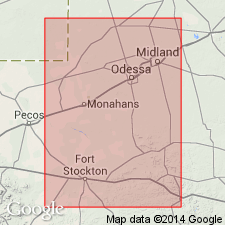
- Usage in publication:
-
- Wink Member
- Modifications:
-
- Named
- Dominant lithology:
-
- Limestone
- Dolomite
- Shale
- AAPG geologic province:
-
- Permian basin
Summary:
Named as the basal member of the newly named Wristen Formation. Occurs only in the subsurface. Identified in Winkler, Andrews, Crane, Ector, Ward, and Upton Cos, TX, Permian basin. Type section is the interval between 17,703 and 17,570 ft in the Phillips Petroleum Co. University Lands "H," sec 11, Blk 17 University, Winkler Co, TX where it consists of soft white limestone and gray dolomite in bands (90 percent), dark gray dolomite (5 percent), dark gray shale (5 percent), traces of olive-brown chert. Is thickest at its type. Thins to 15 ft thick in a well in Pecos Co. Overlies Fusselman Formation. Conformably underlies the newly named Frame Member, upper member of Wristen Formation. Cross sections. E-logs. Shown as Late Silurian age on correlation chart. Correlates with Henryhouse Formation, part of Fusselman Formation, and part of Caballos Novaculite. Fossils: ostracods, crinoid fragments, foram AMMODISCUS.
Source: GNU records (USGS DDS-6; Denver GNULEX).
For more information, please contact Nancy Stamm, Geologic Names Committee Secretary.
Asterisk (*) indicates published by U.S. Geological Survey authors.
"No current usage" (†) implies that a name has been abandoned or has fallen into disuse. Former usage and, if known, replacement name given in parentheses ( ).
Slash (/) indicates name conflicts with nomenclatural guidelines (CSN, 1933; ACSN, 1961, 1970; NACSN, 1983, 2005, 2021). May be explained within brackets ([ ]).

